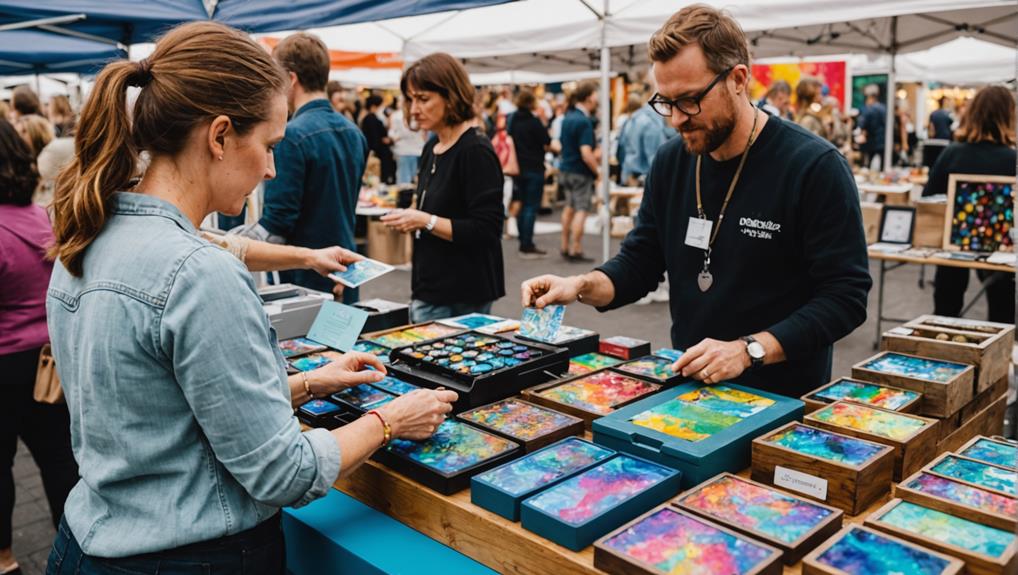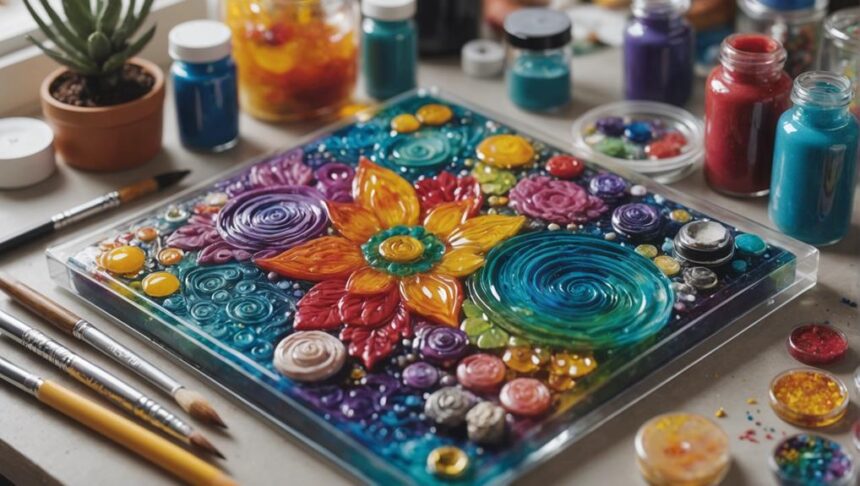So, you're wondering if resin art is expensive? Well, it can be, but it really depends! For a basic set-up, you might spend around INR 1300 to 1500 on essential supplies like resin kits, silicone molds, and gloves. Small projects, like coasters, start affordably but larger ones, like stunning river tables, can soar to INR 20,000 or more. Don't forget, high-quality materials and tools add up, too! Still, resin art can turn into a rewarding hobby or business with the right investment. If you're curious about how to manage costs and get started, there's lots more to uncover!
Key Takeaways
- Initial resin art setup costs range from INR 1300 to 1500 for essential materials.
- Larger projects like river tables can cost INR 20,000 or more.
- Quality epoxy resin, a crucial material, starts at INR 650-700.
- Additional investment in high-grade ASTM-D certified resin enhances durability and project appeal.
Essential Supplies and Materials
Creating resin art necessitates a range of essential supplies and materials that greatly contribute to the initial setup costs.
To begin, you need an epoxy resin crystal clear kit, which is the heart of any resin project. This resin typically ranges from INR 650-700, but specialized varieties can be pricier. Measuring cups and silicone molds are also important, with molds starting at INR 100. These molds shape your resin into beautiful designs, making them a must-have.
Supply sourcing is a significant step. You'll need nitrile gloves, around INR 20, to protect your hands, along with stir sticks and drip sheets to keep your workspace tidy. Heat guns or torches are necessary too, as they remove bubbles from the resin, guaranteeing a smooth finish. These extra tools add to your initial costs, but they're indispensable for high-quality art.
Quality assessment is essential; investing in high-grade materials like ASTM-D certified resin guarantees your artwork is both durable and visually appealing.
While starting costs can seem high, sourcing the right supplies and focusing on quality will pay off in the long run, making your resin art truly shine.
Best Resin Product Kits
Selecting the best resin product kits can greatly streamline your creative process and guarantee you have all the necessary tools and materials to produce high-quality art.
For those new to resin art, resin art kits designed with beginner supplies are an excellent starting point. The Jewelry/Small Project Kit, for instance, is user-friendly and comes packed with essential materials. It includes jewelry molds, complete with holes for jump rings, perfect for making custom pieces that stand out.
If you're aiming for larger projects, like crafting a stunning coffee table, the Larger Project Kit has you covered. This extensive kit includes all the supplies and tools necessary for extensive resin applications, ensuring you won't find yourself mid-project without vital items. A standout feature of some kits is the inclusion of coaster molds, allowing for the creation of both functional and decorative items.
Moreover, a kitchen torch, which is often recommended for bubble removal in larger projects, is a valuable addition to any resin artist's toolkit. It helps achieve a flawless finish, making your resin artwork look professional and polished.
Choosing the right kit can dramatically enhance your resin art experience.
Techniques and Methods
Mastering various techniques and methods in resin art is essential for producing intricate and professional-looking pieces.
To begin with, proper mixing of epoxy resin and hardener in the specified 1:1 ratio is vital. Getting this right means avoiding a soft or tacky finish, ensuring the resin cures perfectly.
Layering techniques can create stunning depth and dimension in your art. Imagine creating an ocean scene where each layer of blue gets darker, drawing the viewer's eye deeper into the piece. These layers make your designs more intricate and visually appealing.
Pouring methods also make a significant impact. Pouring resin first allows you to position objects within the mold more accurately. Alternatively, placing objects first and then coating them can result in unique textures and effects. It's like choosing whether to sprinkle chocolate chips on top of a cookie or mix them into the dough.
Toothpicks are your best friends here. They help arrange embedded elements and pop those pesky air bubbles, ensuring a smooth finish.
Experimenting with different pouring methods can lead to surprising and creative outcomes. Each project becomes a unique masterpiece, making resin art an exciting and versatile hobby.
Project Ideas and Costs
Understanding the various techniques and methods in resin art provides a solid foundation, but turning these skills into tangible projects also involves considering the associated costs. Different project ideas come with varying price tags, influenced by factors like resin colorants and mold types. For instance, small projects like resin coasters can be relatively budget-friendly, costing around INR 1300-1500 to get started. However, larger, more intricate pieces, such as stunning river tables, can see costs soar to INR 20,000 or more.
When planning a resin art project, it's essential to factor in the cost of materials:
- Epoxy Resin: Quality epoxy resin can start at about INR 650-700, forming the backbone of any project.
- Silicone Molds: Depending on the complexity, mold types can range from simple coaster molds to elaborate furniture molds, impacting the overall cost.
- Resin Colorants: Adding vibrant hues or subtle tints with resin colorants can enhance the final piece but also adds to the expenses.
Additionally, incorporating decorative elements like dried flowers and glitter can boost the artistic appeal but will further increase the budget.
Careful planning and accurate measurements can help minimize waste, making projects more economical in the long run.
Initial Setup Expenses
Setting up for resin art requires an initial investment in essential materials and tools, with costs typically ranging from INR 1300 to 1500. This might sound like a lot, but with some smart budget strategies, you can get started without breaking the bank.
First, you'll need a quality epoxy system, which is vital for a successful project. Expect to spend around INR 650-700 on this, with options like 3:1 ART RESIN costing a bit more. But trust me, it's worth the extra rupees for the quality.
Next, you'll need basic supplies. Silicone molds are essential and can be found for as low as INR 100. Nitrile gloves are another must-have for safety, costing about INR 20. Don't forget about drip sheets to keep your workspace clean, which will set you back around INR 220, and mixing cups for approximately INR 50.
Now, where to get these items? Many online supply sources offer deals and discounts, so keep an eye out. Expanding your toolkit with these budget strategies can make your initial foray into resin art both affordable and fun.
Total Investment Needed
Calculating the total investment needed for resin art involves considering both the initial setup expenses and the costs of expanding your range of projects.
Starting a small resin business can be quite affordable, with an investment breakdown ranging from INR 1300 to 1500 for basic supplies. However, as you look to diversify and create more complex pieces, the costs can rise considerably.
For instance, expanding your range of resin products can require a total investment of INR 5,000 to 10,000. This includes more advanced tools and a wider variety of materials.
Here's a simple investment breakdown:
- Basic Supplies: Epoxy resin kits, silicone molds, and safety gear, costing around INR 650-700.
- Expanded Projects: Additional tools, higher-quality materials, and diverse molds, raising the total to INR 5,000-10,000.
- Larger Projects: River tables or furniture, starting at INR 20,000, due to the higher costs of materials and specialized tools.
When comparing these costs, it's clear that investing in quality materials, such as ASTM-D certified resin, is essential.
This not only guarantees professional results but also builds a strong foundation for long-term success in resin art. Consequently, while the initial costs can be modest, higher investments are necessary for growth and diversification.
Marketing and Sales Tips

Leveraging social media platforms like Instagram and Etsy can greatly enhance the visibility and sales of your resin art. Engaging visuals are key, so make sure to post high-quality photos and videos of your pieces. Using effective social media strategies, such as hashtags and collaborations with influencers, can help you reach a broader audience.
To maintain customer engagement, consider offering seasonal promotions or discounts. Holidays or local craft fairs are perfect times to boost sales and attract new customers. Positive customer reviews and testimonials also play an essential role in building trust. Encourage satisfied buyers to leave feedback as this can notably impact purchasing decisions.
Participating in local markets or craft fairs is another excellent way to gain exposure. Meeting potential customers in person can lead to increased sales and foster a sense of community support. Additionally, collaborating with other artists or local businesses can maximize your marketing efforts through shared resources and networks.
| Marketing Strategy | Benefit |
|---|---|
| Seasonal Promotions | Boosts sales during peak times |
| Customer Reviews | Enhances credibility and trust |
| Collaborations | Expands audience reach |
Profitability and Revenue
Profitability in resin art can be remarkably high, with skilled artists often achieving profit margins exceeding 100%. This art form provides a fantastic opportunity for creators to turn their passion into profit.
There are several ways artists can maximize their earnings:
- Small items like keychains and jewelry: These can be sold at low prices yet still offer high returns on material costs.
- Unique, high-quality products: There's a strong market demand for one-of-a-kind resin pieces, allowing artists to capitalize on trends and boost revenue.
- Continuous learning and experimentation: By constantly improving techniques, artists can enhance both their creative output and business growth.
The initial investment in resin art is relatively low, typically ranging from INR 1,300 to 1,500 for basic supplies. This means artists can quickly offset their costs by selling just a few creations.
With market demand for resin art products on the rise, those with a knack for creativity and a willingness to learn can find this venture particularly lucrative.
Whether you're making a unique jewelry piece or a stunning home decor item, the potential for high profit margins makes resin art an enticing and rewarding pursuit.
Frequently Asked Questions
Why Is Resin Art so Expensive?
Resin art is expensive due to the high cost of resin materials, including specialty resins and aesthetic additives. Additionally, labor costs associated with precise measurement, mixing, and safety precautions further increase the overall expense of the craft.
Is Resin Art an Expensive Hobby?
Resin art can indeed be an expensive hobby. A thorough cost breakdown reveals significant expenses in resin supplies, including resin and hardener, pigments, and essential safety gear, all of which contribute to the overall investment required.
Does Resin Art Make Money?
Resin art can be highly profitable, benefiting from strategic resin pricing and leveraging current market trends. Skilled artists often achieve profit margins exceeding 100%, particularly by creating unique items that meet consumer demand and capitalize on popular styles.
Does Resin Art Break Easily?
Resin art exhibits notable durability and impact resistance when epoxy resin is properly mixed and cured. However, it remains vulnerable to cracking or shattering under significant force or drops, with thickness and environmental factors influencing its overall strength.
Conclusion
In summary, resin art can be an expensive hobby or business, depending on the quality of supplies, techniques, and project complexity.
Initial setup expenses and total investment can be significant, but effective marketing and sales strategies can lead to profitability and revenue.
By selecting the best resin product kits and mastering various methods, artists can create stunning pieces that may justify the costs.
Ultimately, careful planning and budgeting are essential for success in this creative field.


Leave a Reply